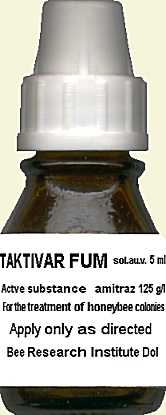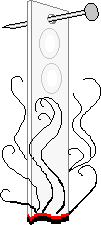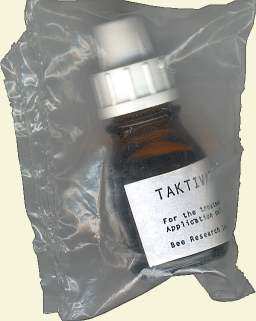| |
Taktivar, (Fumigation Solution of Amitraz)This product is not registered for use in the U.K.
General note on chemicals: I do not endorse or advise on chemical treatments, as I am not qualified to do so and there may be dangers beyond my control. New
products may be introduced or existing ones withdrawn, so it is difficult to keep up with current information on a website such as this. As many of the chemical pages were generated by Dave Cushman, I am leaving the
content mainly as left by Dave for historical purposes only, which may mean information is out of date and unreliable. The user should seek guidance from other sources and satisfy themselves regarding safety and legality.
Roger Patterson.
The
Amitraz
Molecule | |

|
|---|
|
|---|
|
 Manufactured By:-
Manufactured By:-
Bee Research Institute at Dol, 25266 Libcice n. Vlt.
Czech Republic Tel 42 2 6857586 Fax 42 2 6857585
Data Sheet Ref:- (none) Date of Issue of Data:- (not stated)
The data sheet that this information was taken from is believed to have
been prepared for distribution at a Varroa conference organised by the
Leicestershire and Rutland BKA in 1993. Minor editing of bad
translations by myself.
TAKTIVAR FUM sol. a.u.v. 5 ml
active substance: amitraz 125 g/l
INSTRUCTION
VARROA CONTROL
application form: fumigation
The fumigation is applied at an out of door temperature of
+10°C after the bees have finished flying for the day. Prior to
the treatment the hive combs are to be arranged so that there may be
a 40 mm gap between the outer comb and the hive wall.
|
 Immediately before treatment the Taktivar is dropped on to
the strip. One hive box needs 2 drops of solution, if the colony
occupies two boxes then 4 drops must be applied. After the drops of
solution have been allowed to soak into the strip for a few seconds,
the strip is ignited along the whole of the lower edge. The strip
should smoulder, it must not burn. If the strip flares up, the flame
is to be blown out immediately. The smouldering strip is fixed in
vertical position by a nail in the middle of the outer comb so that
the strip is 20 mm from the comb and 20 mm from the hive
wall. Then the hive and the entrance are immediately closed. After one
hour the entrance should be re-opened.
Immediately before treatment the Taktivar is dropped on to
the strip. One hive box needs 2 drops of solution, if the colony
occupies two boxes then 4 drops must be applied. After the drops of
solution have been allowed to soak into the strip for a few seconds,
the strip is ignited along the whole of the lower edge. The strip
should smoulder, it must not burn. If the strip flares up, the flame
is to be blown out immediately. The smouldering strip is fixed in
vertical position by a nail in the middle of the outer comb so that
the strip is 20 mm from the comb and 20 mm from the hive
wall. Then the hive and the entrance are immediately closed. After one
hour the entrance should be re-opened.
If the Taktivar application is for diagnosis, the hive
bottom should be prepared with a sticky insert sheet before the
application. 12 hours after the treatment the sheet should be examined.
One hour after the treatment the nail is removed from the
comb and the strip is examined to ensure a complete burn of the
strip. If the strip did not smoulder completely, the treatment should
be resumed.
(Editors Note! If the portion with the dots is part
consumed then relight the strip and close up again, If however the
strip has 'gone out' before the active substance has been reached...
dispose of the part burned strip and prepare a new one.)
Use a respirator in enclosed spaces!
I neither endorse nor condemn this product. The information
as published here is a matter of public record. The information is
placed here for the education of those that wish to read it. BEFORE
you obtain or use the material concerned please ascertain the legality
of doing so in your location as the product may or may not be approved
in your geographic State or Country.

| |
Supplied in 5 ml dropper bottles in a sealed polythene
sleeve. The bottle is illustrated at top right and the packaging is
illustrated at left. Occasionally packaged with a packet of 50 Dol
Strips and a leaflet in an outer polythene bag.
A 5 ml bottle may seem small, but as the treatment rate is the same as the
diagnosis rate, a bottle will treat 100 or so colonies
|
|---|
Originally written by Dave Cushman. Edited and additions by Roger Patterson.
Page created pre-2011
Page updated 12/12/2022

 Manufactured By:-
Manufactured By:-
 Immediately before treatment the Taktivar is dropped on to
the strip. One hive box needs 2 drops of solution, if the colony
occupies two boxes then 4 drops must be applied. After the drops of
solution have been allowed to soak into the strip for a few seconds,
the strip is ignited along the whole of the lower edge. The strip
should smoulder, it must not burn. If the strip flares up, the flame
is to be blown out immediately. The smouldering strip is fixed in
vertical position by a nail in the middle of the outer comb so that
the strip is 20 mm from the comb and 20 mm from the hive
wall. Then the hive and the entrance are immediately closed. After one
hour the entrance should be re-opened.
Immediately before treatment the Taktivar is dropped on to
the strip. One hive box needs 2 drops of solution, if the colony
occupies two boxes then 4 drops must be applied. After the drops of
solution have been allowed to soak into the strip for a few seconds,
the strip is ignited along the whole of the lower edge. The strip
should smoulder, it must not burn. If the strip flares up, the flame
is to be blown out immediately. The smouldering strip is fixed in
vertical position by a nail in the middle of the outer comb so that
the strip is 20 mm from the comb and 20 mm from the hive
wall. Then the hive and the entrance are immediately closed. After one
hour the entrance should be re-opened.
